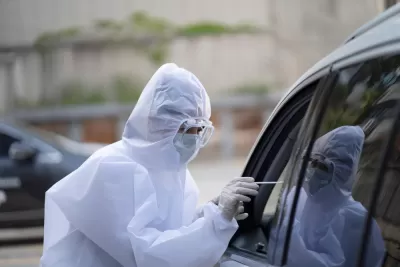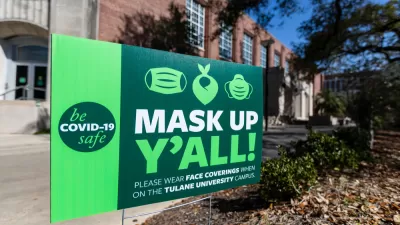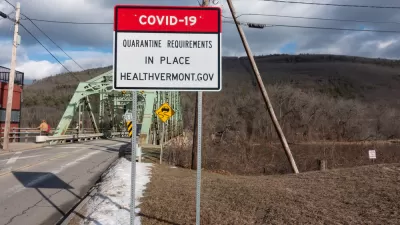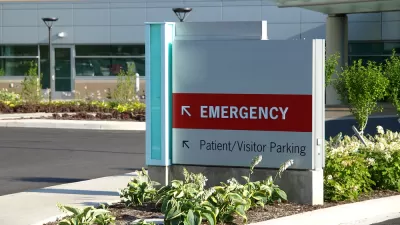"Flatten the curve" was one of the first pandemic terms that Americans heard during the first surge. The idea was to reduce coronavirus transmission so as to prevent hospitals from becoming overwhelmed. But which curve? Case in point: Idaho.

The hospital crisis in the Gem State first hit North Idaho when Kootenai Health in Coeur d'Alene was so overwhelmed with Covid-19 patients that they asked the state Department of Health and Welfare (DHW) to activate crisis standards of care which permit rationing of care as part of a "catastrophic disaster response [pdf]." A declaration [pdf] was declared on Sept. 6 but it only applied to the two northernmost health districts. The 7-day average of daily new cases was 765, according to The New York Times coronavirus database.
"Crisis standards of care is a last resort," stated DHW Director Dave Jeppesen in a press release. "It means we have exhausted our resources to the point that our healthcare systems are unable to provide the treatment and care we expect. This is a decision I was fervently hoping to avoid."
Ten days later, the 7-day average of daily new cases had jumped nearly 60% to over 1,200, according to the Times tracker. Jeppesen activated the Crisis Standards of Care statewide after St. Luke’s Health System conveyed the distressing conditions at their hospitals.
"The situation is dire – we don’t have enough resources to adequately treat the patients in our hospitals, whether you are there for COVID-19 or a heart attack or because of a car accident," said Jeppesen in a press release on Sept. 16.
“We are being absolutely crushed by Covid,” Chris Roth, the president and chief executive of St. Luke’s Health System, which has a network of hospitals across the state, said at a Thursday afternoon news conference, reported Mike Baker and Giulia Heyward for the Times on Sept. 16 (source article).
Hospitalizations for Covid-19 have continued to surge across Idaho, and are now running nearly 40 percent above the previous peak of the pandemic, according to federal data.
The hospitalizations curve
In fact, it's the hospitalization curve in the Times database that really tells the story of what's gone wrong in Idaho. Daily new cases may have peaked at a daily average of 1,400 on Sept. 13, but remained below the prior peak of 1,600 on Dec. 9 during the state's third surge. Daily new cases dipped below 1,200 on Sept. 20.
The hospitalizations graph, which measures daily Covid hospitalizations as opposed to new admittances on the Times tracker, shows a line going almost straight up beginning at the end of July. The prior hospitalization peak was a 7-day average of 470 on Dec. 18, 2020. On Sept. 18, the average was over 700, almost 50% greater, so far. If the typical pandemic pattern holds, it will continue to skyrocket for the next two weeks.
“We are out of actual hospital beds,” Sandee Gehrke, the chief operating officer for St. Luke’s Health System, said at the news conference, saying that patients are now being treated on stretchers.
Measures to flatten the curve – not taken
Flattening the curve meant taking action to reduce viral spread. In California, outdoor dining was shut down in early December in anticipation of a hospital crisis and didn't return until late January. More recently, Louisiana Gov. John Bel Edwards issued an indoor masking mandate on Aug. 2, but refused to impose business restrictions as hospitalizations surged and crisis care standards were drafted, though it's not clear if they were enacted as they are in Idaho.
Idaho's governor, Brad Little, has done neither, to the frustration of one of the neighboring states.
Despite the spreading crisis, Gov. Brad Little has resisted imposing new coronavirus restrictions or mandating mask-wearing and vaccinations. That has led to growing frustration in neighboring Washington State, which has an indoor mask mandate and other safety protocols, and where hospitals have been strained by numerous patient transfers from Idaho.
It could be worse
However, Little's resistance to imposing public health measures to flatten the hospitalization curve, which as of Sept. 21 is a near verticle line, needs to be placed in context. When he traveled to Nashville to attend the Republican Governors Association’s spring conference in late May, Lieutenant Janice McGeachin seized the opportunity to issue an executive order to ban mask mandates imposed by local governments and school districts, reported the Times on May 28.
It said that wearing masks had done “significant physical, mental, social and economic harm,” that they failed to serve a health or safety purpose and that they “unnecessarily restrict the rights and liberties of individuals and business.”
Upon his return, Little reversed the order, noting that he too opposed mandates but also opposed preempting local authorities from acting to protect the health of their constituents.
For the record, though, I have opposed a statewide mask mandate all along because I don’t think top-down mandates change behavior the way personal choice does.
But, as your Governor, when it came to masks, I also didn’t undermine separately elected officials who, under Idaho law, are given authorities to take measures they believe will protect the health and safety of the people they serve.
Consequently, Idaho is not among the six states (according to USA TODAY on Sept. 20) that have banned school districts from acting in accordance with CDC guidance by requiring universal indoor masking.
Vaccination levels
It would be incomplete to not mention Idaho's low vaccination level. As Sen. Bill Cassidy (R-La.) said recently, COVID-19 is "essentially a vaccine-preventable disease."
Idaho, Wyoming, and Alabama, with 41% of their residents fully vaccinated, have the nation's second-lowest vaccination level after West Virginia with 40%, according to the Times coronavirus database as of Sept. 20. The national average is 55%.
Its western neighbor, Washington, on the other hand, has the ninth highest (among states), with 62% of its population fully vaccinated.
However, vaccinated Idaho residents are still at risk – even more so than in much of the country, as infectious disease expert, Dr. Celine Gounder noted in a related post that vaccinated people living in states with high transmission rates are at greater risk of breakthrough infections. KPLX News of Spokane/Coeur d'Alene reported that 13% of the 212 COVID-19 patients hospitalized at Kootenai Health between August 25 and September 8 were fully vaccinated.
Idaho is not alone
"In Montana, St. Peter’s Health in Helena moved into crisis standards Thursday, and Billings Clinic, the largest hospital system in the state, warned it could be next," according to The Washington Post on Sept. 17.
In California’s Fresno County, the interim health officer has said the jurisdiction is at “a tipping point,” but the arrival of out-of-town nurses and medical teams helped stabilize the situation for the moment.
"Alaska’s largest hospital is now implementing crisis standards and rationing medical care amid a crush of COVID-19 patients and staff shortages that have forced providers to prioritize patients most likely to recover," reported the Anchorage Daily News on Sept. 15.
Providence Alaska Medical Center’s chief of staff announced the decision in a two-page letter [pdf] Tuesday that urges Alaskans to wear masks regardless of their vaccination status, get tested, get vaccinated if eligible and avoid potentially dangerous activities or situations that could result in hospitalization.
Like Gov. Little, the mayor of Alaska's largest city expressed resistance to enacting public health measures and coronavirus restrictions to reduce transmission.
Last year, Anchorage enacted strict COVID-19 mitigation measures including mandatory masking and capacity restrictions under prior administrations. Anchorage Mayor Dave Bronson has made it clear he opposes such requirements.
The Times reports on Sept. 14 that "[h]ospitals in the southern United States are running dangerously low on space in intensive care units," with the crisis particularly severe in Texas, Florida and Alabama. The Times coronavirus database on Sept. 21 indicates that Kentucky, West Virginia and Georgia had the nation's highest COVID-19 hospitalization rates, respectively.
Related in Planetizen:
- Louisiana's Health Care System on Brink of Collapse, August 26, 2021
- The Pandemic's Most Critical Health Metric Just Shut Down Most of California, December 7, 2020
- More than a Pause: Reversing the Reopening, June 24, 2020 [Idaho's most populous county shuts down bars and nightclubs to reduce coronavirus transmission]
Hat tip to Shelley Chambers.
FULL STORY: Idaho allows overwhelmed hospitals across the state to ration care if necessary.

Study: Maui’s Plan to Convert Vacation Rentals to Long-Term Housing Could Cause Nearly $1 Billion Economic Loss
The plan would reduce visitor accommodation by 25,% resulting in 1,900 jobs lost.

North Texas Transit Leaders Tout Benefits of TOD for Growing Region
At a summit focused on transit-oriented development, policymakers discussed how North Texas’ expanded light rail system can serve as a tool for economic growth.

Using Old Oil and Gas Wells for Green Energy Storage
Penn State researchers have found that repurposing abandoned oil and gas wells for geothermal-assisted compressed-air energy storage can boost efficiency, reduce environmental risks, and support clean energy and job transitions.

Private Donations Propel Early Restoration of Palisades Playground
Los Angeles has secured over $1.3 million in private funding to restore the Pacific Palisades playground months ahead of schedule, creating a modern, accessible space that supports community healing after recent wildfires.

From Blight to Benefit: Early Results From California’s Equitable Cleanup Program
The Equitable Community Revitalization Grant (ECRG) program is reshaping brownfield redevelopment by prioritizing projects in low-income and environmental justice communities, emphasizing equity, transparency, and community benefits.

Planting Relief: Tackling Las Vegas Heat One Tree at a Time
Nevada Plants, a Las Vegas-based nonprofit, is combating the city’s extreme urban heat by giving away trees to residents in underserved neighborhoods, promoting shade, sustainability, and community health.
Urban Design for Planners 1: Software Tools
This six-course series explores essential urban design concepts using open source software and equips planners with the tools they need to participate fully in the urban design process.
Planning for Universal Design
Learn the tools for implementing Universal Design in planning regulations.
Ascent Environmental
Borough of Carlisle
Institute for Housing and Urban Development Studies (IHS)
City of Grandview
Harvard GSD Executive Education
Toledo-Lucas County Plan Commissions
Salt Lake City
NYU Wagner Graduate School of Public Service





























